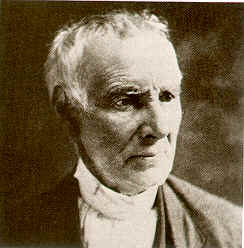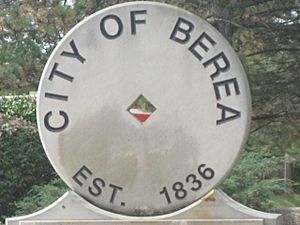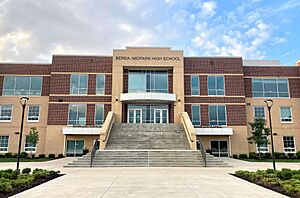Berea, Ohio facts for kids
Quick facts for kids
Berea, Ohio
|
|
|---|---|
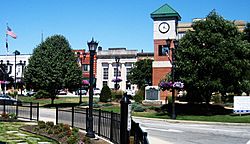
Triangle area of downtown Berea
|
|
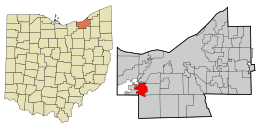
Location in Cuyahoga County and the state of Ohio.
|
|
| Country | United States |
| State | Ohio |
| County | Cuyahoga |
| Established | 1836 |
| Area | |
| • Total | 5.79 sq mi (15.01 km2) |
| • Land | 5.68 sq mi (14.71 km2) |
| • Water | 0.11 sq mi (0.29 km2) |
| Elevation | 787 ft (240 m) |
| Population
(2020)
|
|
| • Total | 18,545 |
| • Estimate
(2023)
|
17,922 |
| • Density | 3,264.96/sq mi (1,260.52/km2) |
| Time zone | UTC-5 (Eastern (EST)) |
| • Summer (DST) | UTC-4 (EDT) |
| ZIP code |
44017
|
| Area code(s) | 440 |
| FIPS code | 39-05690 |
| GNIS feature ID | 1085954 |
| Website | https://www.cityofberea.org/ |
Berea (pronounced bə-REE-ə) is a city in Ohio, located in Cuyahoga County. In 2020, about 18,545 people lived there. It is a western suburb of Cleveland, making it part of the larger Cleveland area. Berea is known for Baldwin Wallace University, the training center for the Cleveland Browns football team, and the Cuyahoga County Fairgrounds.
Contents
History of Berea
Berea was founded in 1836. The first European settlers came from Connecticut. This area was part of Connecticut's Western Reserve. In 1808, Abram Hickox bought land here but settled in Cleveland instead. His nephew, Jared Hickox, and his family arrived in 1809. They traveled through the forest from Cleveland and settled about 2 miles (3.2 km) west of what is now Bagley and Pearl roads.
The Hickox family faced challenges, including illness. Jared's daughter, Amy Hickox, married Abijah Bagley, who took over the family farm. He made it successful, and today, Berea's largest street is named Bagley Road after him.
How Berea Got Its Name
In 1827, an educator named John Baldwin moved to the area. He joined with James Gilruth and Henry Olcott Sheldon, who were Methodist preachers. They wanted to create a perfect Christian community. In 1836, they decided to combine their properties to form a "Community of United Christians."
They tried to choose a name for their new town. Nehemiah Brown suggested "Tabor," but Henry Sheldon suggested "Berea," from a place mentioned in the Bible (Acts 17:10-11). They flipped a coin to decide, and it landed on Berea.
Later, the community faced money problems and broke apart. John Baldwin and Henry Sheldon then worked with Josiah Holbrook to start the Berea Seminary. This school was meant to train teachers. The idea of a community built around a school continued even after the seminary closed.
The Grindstone Capital
John Baldwin started making grindstones from sandstone found in the Rocky River in 1838. By the 1840s, Henry Sheldon began selling them in New York. This was the start of Berea's quarrying industry. When the Big Four Railroad was built, Baldwin built a special railroad line to connect his quarries to it.
In 1845, Baldwin helped start a new school called the Baldwin Institute. It was special because it offered education to everyone, no matter their gender, race, religion, or how much money they had. In 1855, it became Baldwin University. Later, in 1913, Baldwin University merged with German-Wallace College to form Baldwin–Wallace College, which is now Baldwin Wallace University.
Berea also had its first high school, Berea High School, founded in 1882. It closed in 2020, and the new Berea–Midpark High School opened that same year.
Berea Sandstone and Quarries
Berea sits on a type of rock called Berea sandstone. This rock formation is named after the city. It spreads across Ohio and other states. In the 1800s and early 1900s, this sandstone was dug out from large pits called quarries. These quarries grew so big that they even took over the original main street of the town. Baldwin University also sold its first campus to the quarries in 1888 and moved to a new spot.
At first, Baldwin shipped grindstones to Cleveland using ox carts. Later, the quarries were connected to the railroad. Berea proudly calls itself "The Grindstone Capital of the World." The town's symbol is a grindstone, honoring its history.
The quarries also provided sandstone for building materials. Many important buildings were made using Berea sandstone. The quarries closed in the late 1930s when concrete became more popular for construction. Today, some of the lakes in the area, like Baldwin, Wallace, and Coe lakes, are old quarry pits that filled with water.
Historic Places in Berea
Several places in Berea are listed on the National Register of Historic Places. This means they are important historical sites. Some of these include:
- Baldwin-Wallace College North Campus Historic District
- Baldwin-Wallace College South Campus Historic District
- Berea District 7 School
- Berea Union Depot
- Buehl House
- Lyceum Village Square And German Wallace College
- John Wheeler House
- George W. Whitney House
Geography and Nature
Berea is located southwest of Brook Park and west of Middleburg Heights.
According to the 2010 census, the city covers about 5.83 square miles (15.10 km²). Most of this area, about 5.72 square miles (14.81 km²), is land, and a small part, about 0.11 square miles (0.28 km²), is water.
The east branch of the Rocky River flows through Berea. This river provides water for the city for most of the year. The Cleveland Metroparks' Rocky River and Mill Stream Run reservations also run through the city, offering natural spaces.
People of Berea (Demographics)
| Historical population | |||
|---|---|---|---|
| Census | Pop. | %± | |
| 1870 | 1,628 | — | |
| 1880 | 1,682 | 3.3% | |
| 1890 | 2,533 | 50.6% | |
| 1900 | 2,510 | −0.9% | |
| 1910 | 2,609 | 3.9% | |
| 1920 | 2,959 | 13.4% | |
| 1930 | 5,697 | 92.5% | |
| 1940 | 6,025 | 5.8% | |
| 1950 | 12,051 | 100.0% | |
| 1960 | 16,592 | 37.7% | |
| 1970 | 22,396 | 35.0% | |
| 1980 | 19,636 | −12.3% | |
| 1990 | 19,051 | −3.0% | |
| 2000 | 18,970 | −0.4% | |
| 2010 | 19,093 | 0.6% | |
| 2020 | 18,545 | −2.9% | |
| 2023 (est.) | 17,922 | −6.1% | |
| U.S. Decennial Census | |||
In 2010, there were 19,093 people living in Berea. The city had 7,471 households and 4,390 families. The population density was about 3,338 people per square mile (1,289 per km²).
Most residents (88.8%) were White. About 6.6% were African American, 1.5% Asian, and 0.2% Native American. About 2.8% of the population identified as Hispanic or Latino.
The average age in Berea was 37.1 years old. About 18.3% of residents were under 18, and 13.9% were 65 or older. The city had slightly more females (52.3%) than males (47.7%).
Culture and Events
Bach Festival
Baldwin Wallace University is home to the Riemenschneider Bach Institute. This institute focuses on the music of J. S. Bach, a famous composer.
The first college Bach festival in America started here in 1932. It was founded by music educator Albert Riemenschneider and his wife Selma. The festival features Bach's major works, like the Mass in B minor. Students, faculty, and professional musicians perform together.
Education in Berea
The Berea City School District serves Berea and the nearby cities of Brook Park and Middleburg Heights.
Berea–Midpark High School is located in Berea. Berea-Midpark Middle School is in Middleburg Heights. These schools work with Polaris Career Center for special classes. There are three elementary schools: Grindstone (in Berea), Brook Park (in Brook Park), and Big Creek (in Middleburg Heights).
Baldwin Wallace University, a private university, is also located in Berea.
Famous People from Berea
Many notable people have connections to Berea, including:
- Jacob M. Appel (born 1973), a novelist
- John Baldwin (1799–1884), who founded Berea and Baldwin Institute
- Charles Bassett (1931–1966), a NASA astronaut
- Tim Beckman (born 1965), a former college football coach
- Mike Buddie (born 1970), a former MLB baseball player
- Bud Collins (1929-2016), a sportswriter and TV commentator
- Lou Groza (1924–2000), a famous football player for the Cleveland Browns
- Geoffrey Landis (born 1955), a science-fiction author and NASA scientist
- Nancy McArthur, a children's author
- Neil H. McElroy (1904–1972), a former U.S. Secretary of Defense
- Rob Mounsey (born 1952), a composer and musician
- Tom Schmitz (born 1968), keyboardist for the band Mushroomhead
- Christina Tosi (born 1981), a chef and owner of Milk Bar
- Jim Tressel (born 1952), a university president and former football coach
- James Wallace (1821–85), a quarry owner and former mayor of Berea
Images for kids
See also
 In Spanish: Berea (Ohio) para niños
In Spanish: Berea (Ohio) para niños


